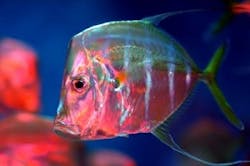U.S. Navy funded group discovers some fish have polarization-based camouflage
Austin, TX and Portland, OR--Researchers at the University of Texas at Austin (UTA) and the University of Portland have found that certain ocean fish camouflage themselves with a polarization-dependent reflective outer surface that changes properties to match polarization conditions ("polaro-crypsis").1 The research was funded by the U.S. Navy, which has an interest both in developing better ocean camouflage technologies and in being able to detect such strategies if developed by others.
Because the fish live in the open ocean with nothing to hide behind or under, camouflage is especially important. One form of camouflage is a simple reflective skin, which many fish have; this type of skin reflects adequately if the sun is high in the sky and therefore resulting in mostly unpolarized light underwater.
If the sun is low in the sky, however, the water surface reflects one polarization more than the other, creating polarized light underwater (an "asymmetric polarized radiance field"). The result for ordinary reflective fish skin, which is actually scattering as well as reflective, is that the fish becomes more visible from certain viewing angles when the sun is low in the sky.
Changeable polarization camouflage
To overcome this problem, certain open-ocean fish have developed polarization-based reflective camouflage. To quantify the properties, the researchers compared open-ocean fish, such as the lookdown fish, to seagrass-dwelling fish, such as the pinfish, using polarization imaging in the lab to map their reflective qualities in polarization-contrast space—and found that the lookdowns were able to manipulate their reflective properties in ways that were close to the theoretical optimum, and far better than a standard mirror.
Related: Polarization difference imaging camera reveals 'unseen' features
"The nifty thing is when we mimicked the light field when the sun is overhead, as it would be at noon, the fish just bounced back that light field," says Molly Cummings, associate professor of integrative biology in the College of Natural Sciences at UTA. "It acted like a mirror. Then we mimicked the light field when it's more complex, and the lookdown altered the properties of the polarized light it was reflecting so that it would be a better blend into its specific background at different times of day."
The lookdown's polaro-cryptic mirror skin functions by selectively reducing the degree of polarization and transforming the angle of polarization of the reflected light depending on the conditions.
Fish see polarization
"In the polarized light field, there is a lot of structure in the open ocean," says physicist Parrish Brady, a postdoctoral associate in Cummings' lab. "Humans can't see it, but more than 60 different species of fish have some degree of polarization sensitivity. They can perceive the structure in the light."
The contours of the polarized light field in the open ocean environment are constantly changing except at noon, when the sun is directly overhead. So, just as Cummings hypothesized, fish need to do more than deploy the straight mirror strategy in order to stay camouflaged.
The researchers' next task is to understand how the fish are accomplishing this feat. Cummings thinks it might be an entirely passive process, with different elements of their skin automatically responding to the angle of the sunlight. Or, the lookdowns may aid in their camouflage by subtly altering their bodies' orientation relative to the sun, or by neurologically ramping up certain processes.
What the researchers discover about these mechanisms will be of particular interest to the Navy, which at present isn't as good as lookdown fish are at open-ocean camouflage.
REFERENCE:
1. Parrish C. Brady et al., Proceedings of the National academy of Sciences (PNAS), published online before print, May 28, 2013, doi: 10.1073/pnas.1222125110
About the Author
John Wallace
Senior Technical Editor (1998-2022)
John Wallace was with Laser Focus World for nearly 25 years, retiring in late June 2022. He obtained a bachelor's degree in mechanical engineering and physics at Rutgers University and a master's in optical engineering at the University of Rochester. Before becoming an editor, John worked as an engineer at RCA, Exxon, Eastman Kodak, and GCA Corporation.

